

Categories: 2008
Date: Sep 6, 2008
Title: Alessandro Mendini: Redesign and Revival
Gallery Interart: 9/6/2008 ~ 10/31/2008
“There is design and there is the research of the soul, of objects that will have contact with the souls of the people”.
The soul that Alessandro Mendini intends to bestow upon his objects is the emotional connection human can make with the objects. The visual language he uses to create a soul in an object is decoration, the redesign of the object. Through this redesign, obsolete object can be given life and possess a new meaning, reviving the new inherent identity of itself and at last acquiring a new design mechanism that provides excitement and sensibility to the insipid life of ours.
In other words, by applying decoration, a device rejected by fundamentalism, Alessandro Mendini acquired a type of design that sets itself apart from the cold and rational design of modernism, by its warm affection and wide spectrum of emotion. Moreover, Mendini transforms an object of simple and functional form with restrained use of color into something that encompasses a feature of visual utopia by applying decoration.
Anna G—one of Mendini’s most well-known designs piece—is a good example of the demonstration of visual utopia. “Anna G” is a design that has its origin in a human gesture. Alessandro Mendini related the graceful gesture of a ballerina holding her arms high in the air and then putting them down slowly, to the mechanism of a corkscrew, thus bestowing a imagery fantasy of a ballerina on a mere corkscrew. Also, naming this corkscrew after his friend Anna Gili and Alessandro Mendini himself—thus inserting his own story to the design—gives the design a new significance that is both personal and warm-hearted. Though time changes, human beings are always attracted to the familiar human form. Also, that human form reminds us of our innocent childhood, generating nostalgia. In fact, Mendini’s design acts as a medium that builds a connection between the self from the past and the self in present. A totem within a human mind is expressed in a sophisticated way, through Anna G.
 |
 |
| Anna G, corkcrew red, Alessi | | Alessandro M, corkcrew(AAM23 R) , Alessi |
Alessandro Mendini
“Thonet chair redesign”, “Wassily chair redesign”, and “Kandissi sofa” are examples of the revival of preexisting furniture through decoration—redesign.
 |
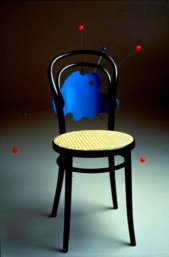 |
| No.14 chair, 1859, Michael Thonet | Redesigned Thonet chair,1978 Studio Alchimia, Milan |
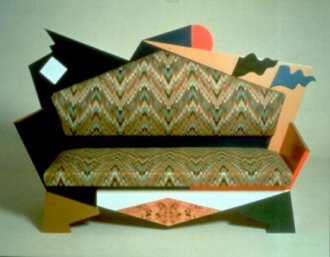 |
|
| Kandissi Sofa, 1978, Studio Alchimia, Milan | |
Also, there are Byblos Casa furniture that are most characterized by their bright and vivid colors and patterns on antique furniture. Through these furniture, Mendini shows how the past—the antique furniture—can be reinterpreted in the present through redesign.
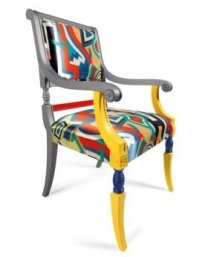 |
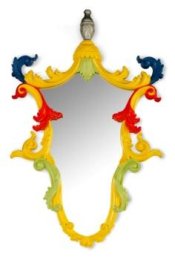 |
| Appiani, Chair with arm in wood and fabric , 57x54x90(H) cm, Byblos Casa | Rossetti, mirror, frame in wood, 60x4x110(H) cm, Byblos Casa |
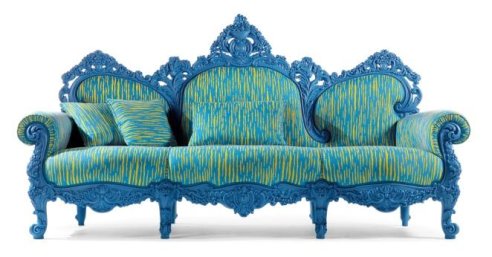 |
|
| Murillo, sofa three seats in wooden fabric, 255x100x125(H) cm, Byblos Casa | |
Then, through the “Poltrona di Proust” Mendini demonstrates how artistic approach to an object results in an artistic aura. Inspired by the novel “In Search of Lost Time”, written by Marcel Proust, Alessandro Mendini interestingly mixes Paul Signac’s pointillism with Proust’s ideology, and creates a masterpiece of postmodernism touch.
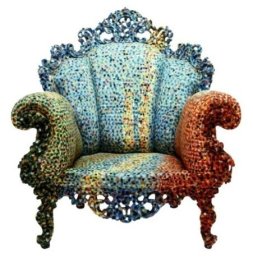 |
| Poltrona di Proust, armchair, 100x100x100(H) cm |
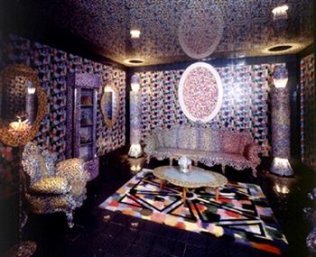 |
| Interno di un Interno(Inside of an inside), 1991, Dilmos show room exhibition, Milano |
In fact, the Proust armchair takes up a big part of Mendini’s design. As one of the most acclaimed work of Mendini, the chair makes it possible to see abundant details of Mendini’s method and ideology behind his design.
To understand Mendini’s ideology, it is necessary to take a close look at the novel In Search of Lost Time. In the novel, the narrator states: “memory—not about the place where I am right now, but about a couple of places I had lived before, and been before—descends upon me like a savior from above and rescues me from the emptiness which I cannot escape by myself.” In other words, for us who live in a constant fear of time that everything that exists eventually disappears by time, memory is a clue that leads us to remember our identity; and at the same time it revives the value and significance of our life.
Although eventually everything disappears in the flow of time—past, present, and future—, through the reminiscence of memory one can rediscover his identity, and thus his “lost time”(cronos—passing time) becomes the “time regained”(kairos—meaningful time). A Madeleine that triggers memory when the narrator takes a bite in the novel transforms into a point of color in Mendini’s Poltrona di Proust.
In the Poltrona di Proust, the points of colors are not only intended for visual attraction, but they also represent little fragments of memory that provides us chance to reminisce the meaning of life, in infinity in space and time. In the novel the little segments of language bring out memory, eventually making a uniform image and grand significance; although the segments of memory is random in time and space, the memories form a uniform piece of identity beyond the special and chronological boundary. Similarly, formation of the dots of color in Poltrona di Proust also visualizes the supernatural sense of time and space. This, in fact, is the visual utopia Alessandro Mendini creates.
As Marcel Proust quoted, “a travel that truly lets us discover something new is not to see a new scene, but to have new eyes to see the scene”. Similarly, Mendini’s design does not lean towards something new, something of new format. He rather redesigned something of an existing form—for instance an antique chair—with Paul Signac’s pointillism and Marcel Proust’s ideology, and successfully transformed the inherent essence of the object and also gave a new significance. And then it is the viewer’s part to relate himself to the object.
Mendini’s visual utopia is even more conspicuous in his style of architecture. By looking at his architectural drawings and models, one may even get the feeling that he is not living in the same world we are living in. His decoration—his redesign—lets the fantasy flow endlessly along the various forms and colors that beauty penetrates inward into private, and it turns itself into a visual language that is poetic and fairy tale-like. An innocent and magical image that everyone may have dreamed of in childhood is rediscovered in his design.
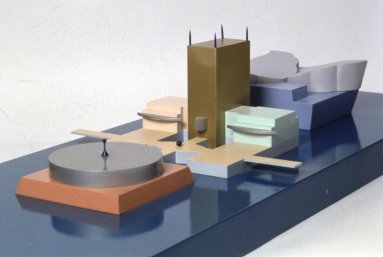 |
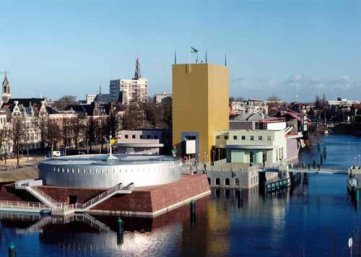 |
| Groninger Museum, Groningen, architectural model in wood, 150x50x60(H) cm / Groninger Museum |
 |
| Alessandro Mendini, drawing |
Since the emergence of Modernism, decoration had been regarded as something against the evolution of art. However, if the history of design evolved around Fundamentalism, design was bound to be seen as something that lacks affection and personal touch. The value of Alessandro Mendini’s design lies on the warm feeling it generates. Mendini’s design, with warm colors and proverbial form, provides an inspiration of a fairy-tale to the reality we live in. Perhaps Mendini is suggesting us to start a conversation with his objects, and meet our own innocent selves.
Written by_Ji Yeon Lee Translated by_Hae Ryung Park